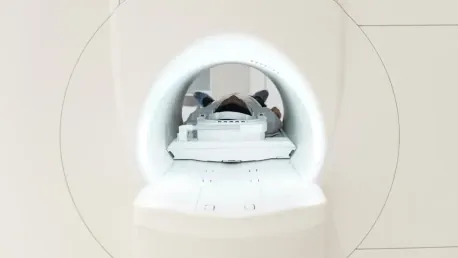Magnetic resonance imaging (MRI) is a cornerstone of modern medical diagnostics, offering detailed images of internal body structures. The technique relies on powerful magnets to map molecules like water and fat, but detecting other substances, such as metabolites, is challenging due to their low concentrations. Hyperpolarization techniques enhance the MRI signal of these molecules, but quality control remains a significant hurdle. Recent advancements in atomic sensor technology, particularly optically pumped atomic magnetometers (OPMs), promise to transform the monitoring of hyperpolarized molecules, improving MRI quality control.
Enhancing MRI with Hyperpolarization
The Basics of Hyperpolarization
Hyperpolarization is a technique that prepares a substance outside the body to bring its magnetization close to its theoretical maximum, increasing the signal strength thousands of times over and making previously undetectable molecules visible during MRI scans. Hyperpolarized substances can then be injected into a patient, targeting specific organs or tissues for detailed imaging. Ensuring that the substance has been adequately hyperpolarized before clinical use is crucial for maximizing the efficacy of the MRI scan.
Despite its immense potential, hyperpolarization presents several challenges, most notably in quality control. The hyperpolarized materials must be monitored to ensure they retain their enhanced magnetization levels. This monitoring ensures that the MRI scans will produce accurate and reliable images, crucial for diagnostic purposes. However, traditional methods of quality control often falter in this high-stakes scenario, necessitating the development of new, more advanced technologies to bridge the gap and ensure the highest level of accuracy and effectiveness in medical imaging.
Challenges in Quality Control
Traditional quality control methods for evaluating the hyperpolarization levels of substances face two main issues. The first issue is that the read-out process of these methods often reduces the magnetization of the sample, thereby diminishing its effectiveness for the MRI scan. This reduction means that by the time the substance is ready for use, its improved properties are already partially spent, impacting the quality of the scan.
The second issue is that these conventional techniques can be time-consuming. During this prolonged period, the substance’s magnetization may decay, reducing the opportunity for additional measurements. This time lag can lead to a lack of crucial data that is necessary for optimizing the hyperpolarization process. Additionally, this decay means that traditional methods may fail to detect magnetization loss during the transport of the substance to the MRI machine. The result is a compounded inefficiency that can ultimately affect diagnostic outcomes, underscoring the need for real-time, non-invasive quality control measures.
Atomic Sensors: A Breakthrough in Monitoring Hyperpolarized Materials
Introduction to Optically Pumped Atomic Magnetometers (OPMs)
Researchers from the Institute for Bioengineering of Catalonia (IBEC) and the Institute of Photonic Sciences (ICFO) have introduced atomic sensor technology to address these limitations. Optically pumped atomic magnetometers (OPMs) offer a fundamentally different operating principle, allowing for real-time detection of fields produced by hyperpolarized molecules. This enables continuous, high-resolution, and non-destructive observations throughout the hyperpolarization process, marking a significant leap from traditional methods.
The key advantage of OPMs lies in their ability to provide a continuous stream of data without the limitations of resolution that conventional techniques face. Instead of capturing a series of still images, akin to snapshots, OPMs deliver what can be likened to a video. This comprehensive and dynamic view of the hyperpolarization process ensures that no details are missed, offering an unprecedented level of insight and control. Despite the sophistication of this technology, the ease with which it can be integrated into existing workflows makes it a practical choice for enhancing MRI quality control.
Advantages of OPMs
OPMs bring a host of benefits to the table, starting with their ability to provide continuous observation without the resolution limits characteristic of traditional quality control methods. This translates into a comprehensive ‘video’ of the hyperpolarization process rather than a sequence of ‘still photos.’ According to Dr. Michael Tayler, this method enhances the quality control of hyperpolarized materials by offering real-time monitoring and insights that are simply unattainable with older technologies.
Moreover, the non-destructive nature of OPM observations means that the magnetization of the sample remains intact during the read-out process. This preservation is crucial for ensuring that the hyperpolarized substance retains its enhanced properties until it reaches the MRI scanner and is injected into the patient. The result is a more effective and reliable MRI scan, which can make a significant difference in diagnostic accuracy. The combination of these advantages positions OPMs as a game-changer in the field of MRI hyperpolarization, offering a level of performance and reliability that traditional methods cannot match.
Unveiling Hidden Spin Dynamics
Real-Time Tracking Capabilities
The researchers tested their OPMs by monitoring the hyperpolarization of clinically relevant molecules, specifically the metabolite compound [1-13C]-fumarate. The unprecedented resolution and real-time tracking capabilities of atomic sensors allowed the team to uncover previously unnoticed ‘hidden spin dynamics’ in the polarization process. These dynamics, which had been obscured by earlier methods, offer a new pathway to optimize hyperpolarization right from the onset of the process. This newfound insight could lead to significant improvements in the effectiveness of MRI scans.
The ability to track these hidden dynamics in real-time provides an additional layer of control and precision. By capturing subtle oscillations in the magnetization profile that were previously undetectable, OPMs enable researchers to identify and address potential issues before they affect the quality of the scan. This preemptive approach is essential for maximizing the benefits of hyperpolarization and ensuring that the MRI scans are of the highest possible quality. The integration of such advanced monitoring capabilities represents a major step forward in the field of medical imaging.
Discovering Unexpected Behaviors
In their research, the team discovered unexpected behaviors when repeatedly magnetizing and demagnetizing the hyperpolarized fumarate molecule. Contrary to their expectations of a smooth transition, the molecule exhibited complex dynamics with hidden resonances at certain magnetization-demagnetization cycles and magnetic fields. This newfound understanding has significant implications for the hyperpolarization process, allowing for adjustments in parameters, such as the duration of the cycle or the intensity of the magnetic field, to prevent unwanted behaviors and optimize results.
These discoveries highlight the importance of continuous, high-resolution monitoring in revealing nuances that would otherwise go unnoticed. By capturing these complex dynamics, OPMs provide a more detailed and accurate picture of the hyperpolarization process, paving the way for more effective and reliable MRI scans. This level of detail is critical for making informed adjustments and improvements, ensuring that the hyperpolarized substances are as effective as possible when used in clinical settings. The insights gained from these observations could lead to significant advancements in the field of medical imaging, ultimately benefiting patient outcomes.
Collaborative Success and Technological Advancements
Interdisciplinary Collaboration
The collaboration between IBEC’s Molecular Imaging for Precision Medicine group and ICFO’s Atomic Quantum Optics group was instrumental in achieving these breakthroughs. The combined expertise in hyperpolarization methods from IBEC and OPM sensing technologies from ICFO proved critical in overcoming the challenges associated with monitoring hyperpolarized materials. Dr. James Eills, the first author of the article, acknowledged the significance of interdisciplinary collaboration in achieving these novel results. Proximity of IBEC and ICFO facilitated close cooperation, enabling the teams to work together effectively and efficiently.
This collaborative effort underscores the importance of bringing together diverse fields of expertise to tackle complex problems. The successful integration of hyperpolarization and OPM technologies demonstrates the potential for interdisciplinary approaches to drive innovation and advancements in medical imaging. As the research progresses, such collaborations will continue to play a crucial role in pushing the boundaries of what is possible in the field, leading to new and improved methods for enhancing diagnostic accuracy and patient outcomes.
Ease of Use and New Information
Dr. Tayler emphasized the ease of use and the plethora of new information revealed by OPM measurements, indicating their potential as powerful tools for hyperpolarization monitoring. The continuous, high-resolution, and non-destructive monitoring provided by OPMs represents a significant advancement in the field of hyperpolarized MRI technology. According to Dr. Tayler, the ability to capture and analyze real-time data without the limitations imposed by traditional methods opens up new possibilities for improving MRI scans.
The wealth of new information made accessible by OPMs allows researchers and clinicians to gain a deeper understanding of the hyperpolarization process, identifying and addressing issues that were previously undetectable. This enhanced level of insight can lead to more effective and reliable MRI scans, ultimately benefiting patient care. The ease with which OPMs can be integrated into existing workflows further adds to their appeal, making them a practical and valuable addition to the toolkit of medical imaging professionals. The combination of these factors positions OPMs as a transformative technology in the field of MRI hyperpolarization quality control.
Future Implications and Applications Beyond MRI
Integration into Clinical Sample Quality Control
The immediate application of these findings is in integrating portable atomic sensors into clinical sample quality control for MRI. The ICFO team is currently implementing this in the Spanish Ministry Project “SEE-13-MRI.” This integration allows for guiding molecules to the highest possible polarization level and reliably certifying the polarization level before patient injection. Such advancements could significantly reduce the cost and logistical challenges of metabolic MRI, potentially expanding its reach from a few specialized research centers to many hospitals worldwide.
The ability to ensure the highest polarization levels before clinical use means that patients can receive the most accurate and effective MRI scans possible. This improvement has the potential to enhance diagnostic capabilities and patient outcomes, making MRI an even more valuable tool in the medical field. Additionally, by reducing the costs and logistical challenges associated with metabolic MRI, broader access can be provided to this advanced imaging technique, benefiting a larger number of patients and healthcare providers.
Broader Applications of Atomic Sensors
The potential of atomic sensors extends beyond medical imaging. The non-destructive, real-time tracking system using OPMs can be applied to monitor macromolecules in chemical processes, study high-energy physics targets, or optimize spin-based algorithms in quantum computing. Dr. Tayler highlighted the broader implications of this technology, noting that its ability to provide precise and continuous monitoring opens new avenues for research and development across a variety of fields.
In chemical processes, for example, the ability to monitor macromolecules in real-time could lead to more efficient and effective manufacturing techniques. In high-energy physics, precise tracking of target materials can improve experimental accuracy and outcomes. In the realm of quantum computing, optimized spin-based algorithms can enhance computational power and efficiency. The versatility and potential of atomic sensors, as demonstrated by OPMs, provide a glimpse of the far-reaching impact this technology could have across multiple scientific and industrial domains. The future promises exciting developments as researchers and innovators continue to explore and harness the capabilities of atomic sensors.
Conclusion
Magnetic resonance imaging (MRI) is a cornerstone in modern medical diagnostics because it provides highly detailed images of internal body structures. The technique operates using powerful magnets to map molecules such as water and fat. However, detecting other substances, like metabolites, poses a challenge due to their low concentrations. To address this, hyperpolarization techniques are used to enhance the MRI signal from these molecules, although maintaining consistent quality control remains a notable challenge. Recently, advancements in atomic sensor technology, especially the development of optically pumped atomic magnetometers (OPMs), offer promising improvements. These OPMs can significantly boost the monitoring of hyperpolarized molecules, paving the way for better quality control in MRI scans. These advancements could revolutionize the precision and reliability of MRI, leading to more accurate diagnoses and improved patient outcomes, ultimately transforming the landscape of medical imaging technology.









